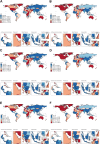Global, regional and national burdens of major depression disorders and its attributable risk factors in adolescents and young adults aged 10-24 years from 1990 to 2021
- PMID: 40251551
- PMCID: PMC12007280
- DOI: 10.1186/s12888-025-06772-w
Global, regional and national burdens of major depression disorders and its attributable risk factors in adolescents and young adults aged 10-24 years from 1990 to 2021
Abstract
Background: Major depressive disorder (MDD) is an important public health problem among adolescents and young adults, and its increasing prevalence underscores the need for region-specific and age-specific interventions. Despite its increasing burden, comprehensive data on regional and longitudinal trends in MDD among adolescents are scarce. This study analyzed global, regional, and national trends in MDD incidence, prevalence, and disability-adjusted life years (DALYs) among individuals aged 10-24 from 1990 to 2021, while examining differences by gender, age, socio-demographic factors, and emerging risk factors to guide targeted mental health strategies.
Methods: With data from the 2021 Global Burden of Disease Study, we conducted an analysis of age-standardized incidence, prevalence, and DALYs due to MDD by sex, age group, and 21 geographic regions with a special focus on sociodemographic index (SDI) levels, which measures development on a scale from low to high. Key risk factors, such as bullying and intimate partner violence, were also assessed in order to understand their contribution to the burden of MDD.
Results: Between 1990 and 2021, the global burden of MDD increased substantially. Prevalence rose by 56.36% globally, particularly among men and young adults aged 20-24 years, with the largest increases observed in Eastern Sub-Saharan Africa (184.26% increase). Incidence grew by 56.11%, with Eastern Sub-Saharan Africa experiencing the steepest rise compared to slower increases in other regions. DALYs also increased by 56.32%, with the greatest burden observed in Eastern Sub-Saharan Africa. Bullying and intimate partner violence were leading contributors to DALYs across all regions. Bullying and childhood sexual abuse increased MDD-related DALYs, with bullying peaking at ages 10-14, while childhood sexual abuse had a higher impact on females, rising sharply after 2006. Post- 2020, all metrics (prevalence, incidence, and DALYs) rose sharply, particularly in high-SDI regions, likely due to the specific impacts of the COVID- 19 pandemic, such as prolonged lockdowns, increased social isolation, and disruptions to mental health services.
Conclusions: This study highlights the need for culturally sensitive mental health policies focusing on prevention and early intervention, while also providing insights to improve resource allocation and support further research on adolescent mental health.
Trial registration: Not applicable.
Keywords: Adolescents; Incidence; Major depressive disorders; Risk factors; Young adults.
© 2025. The Author(s).
Conflict of interest statement
Declarations. Ethics approval and consent to participate: This study utilizes publicly available, de-identified data from the Global Burden of Disease (GBD) study, provided by the Institute for Health Metrics and Evaluation ( https://vizhub.healthdata.org/gbd-results ). As the data are de-identified and do not involve direct human participation, institutional ethics approval was not required. The study was conducted in full accordance with the ethical principles outlined in the Declaration of Helsinki ( https://www.wma.net/policies-post/wma-declaration-of-helsinki/ ). Consent for publication: Not applicable. Competing interests: The authors declare no competing interests.
Figures




Similar articles
-
The long-term spatio-temporal trends in burden and attributable risk factors of major depressive disorder at global, regional and national levels during 1990-2019: a systematic analysis for GBD 2019.Epidemiol Psychiatr Sci. 2024 May 20;33:e28. doi: 10.1017/S2045796024000295. Epidemiol Psychiatr Sci. 2024. PMID: 38764153 Free PMC article.
-
Burden and attributable risk factors of non-communicable diseases and subtypes in 204 countries and territories, 1990-2021: a systematic analysis for the global burden of disease study 2021.Int J Surg. 2025 Mar 1;111(3):2385-2397. doi: 10.1097/JS9.0000000000002260. Int J Surg. 2025. PMID: 39869379
-
Global trends of depressive disorders among women of reproductive age from 1990 to 2021: a systematic analysis of burden, sociodemographic disparities, and health workforce correlations.BMC Psychiatry. 2025 Mar 20;25(1):263. doi: 10.1186/s12888-025-06697-4. BMC Psychiatry. 2025. PMID: 40114132 Free PMC article.
-
Psychosocial alterations during the COVID-19 pandemic and the global burden of anxiety and major depressive disorders in adolescents, 1990-2021: challenges in mental health amid socioeconomic disparities.World J Pediatr. 2024 Oct;20(10):1003-1016. doi: 10.1007/s12519-024-00837-8. Epub 2024 Aug 20. World J Pediatr. 2024. PMID: 39162949 Review.
-
The contribution of bullying victimisation to the burden of anxiety and depressive disorders in Australia.Epidemiol Psychiatr Sci. 2019 Sep 19;29:e54. doi: 10.1017/S2045796019000489. Epidemiol Psychiatr Sci. 2019. PMID: 31533868 Free PMC article.
References
-
- Yan G, Zhang Y, Wang S, Yan Y, Liu M, Tian M, Tian W. Global, regional, and national temporal trend in burden of major depressive disorder from 1990 to 2019: An analysis of the global burden of disease study. Psychiatry Res. 2024;337:115958. - PubMed
-
- Schulenberg JE, Sameroff AJ, Cicchetti D. The transition to adulthood as a critical juncture in the course of psychopathology and mental health. Dev Psychopathol. 2004;16(4):799–806. - PubMed
MeSH terms
LinkOut - more resources
Full Text Sources
Medical

